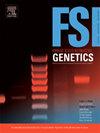评估标记面板大小对估算生物地理共存比例的影响。
IF 3.1
2区 医学
Q2 GENETICS & HEREDITY
引用次数: 0
摘要
在过去的十年中,法医生物地理祖先(BGA)分析已经开发了大量的祖先信息标记面板,为悬案的调查提供了有价值的工具。毛细管电泳(CE)和大规模平行测序(MPS)的分析主要集中在主要种群的分化上,MPS允许更多数量的标记同时进行多重转换,从而改善了更密切相关的欧亚种群的分化。BGA推理工具的一个限制是处理混合背景的个体的共同祖先,这导致两种情况无法区分:(i)个体属于混合种群,或(ii)个体最近的祖先来自不同的种群。准确和精确的共同祖先估计可以提供帮助,因为一级或二级混合将显示出共同祖先比例的~ 50-50 %或~ 75-25 %。在这里,我们比较了从1000基因组计划中获得的2504个个体的共同祖先比例估计值,这些估计值使用了不同大小的专用BGA和人类鉴定(ID)测定,与使用> 500,000 SNP Affymetrix人类起源面板作为每个个体的参考点所获得的估计值进行了比较。对> 500个混合个体进行的相关分析结果表明,面板大小在共同祖先估计的准确性中起主要作用。因此,我们评估的大型法医MPS ID面板构成了中小型BGA面板的有价值的替代方案,特别是在预期添加剂的情况下。本文章由计算机程序翻译,如有差异,请以英文原文为准。
Evaluating the effect of marker panel sizes on estimation of bio-geographical co-ancestry proportions
A large number of ancestry-informative marker panels have been developed for forensic bio-geographical ancestry (BGA) analysis during the past decade, which offer valuable investigative tools for cold cases. The developed assays for capillary electrophoresis (CE) and massively parallel sequencing (MPS) focus on the differentiation of major populations, with MPS allowing larger numbers of markers that can be multiplexed at the same time and therefore improved differentiation of more closely related Eurasian populations. One limitation of BGA inference tools is the handling of co-ancestry in individuals with admixted backgrounds, which leads to two situations being indistinguishable: (i) the individual belongs to an admixed population, or (ii) the individual has recent ancestors from different populations. Accurate and precise co-ancestry estimates can help, as first or second-degree admixture would show a ∼ 50–50 % or ∼ 75–25 % ratio of co-ancestry proportions. Here we compared the co-ancestry proportion estimations obtained for the set of 2504 individuals from the 1000 Genomes Project with dedicated BGA and human identification (ID) assays of different sizes compared to those obtained with the > 500,000 SNP Affymetrix Human Origins panel as the point of reference for each individual. The results of the correlation analysis performed with > 500 admixed individuals indicate that panel size plays a major role in the accuracy of the co-ancestry estimates. Therefore, the large-scale forensic MPS ID panels we evaluated constitute a valuable alternative to small- and medium-scale BGA panels, especially when admixture is expected.
求助全文
通过发布文献求助,成功后即可免费获取论文全文。
去求助
来源期刊
CiteScore
7.50
自引率
32.30%
发文量
132
审稿时长
11.3 weeks
期刊介绍:
Forensic Science International: Genetics is the premier journal in the field of Forensic Genetics. This branch of Forensic Science can be defined as the application of genetics to human and non-human material (in the sense of a science with the purpose of studying inherited characteristics for the analysis of inter- and intra-specific variations in populations) for the resolution of legal conflicts.
The scope of the journal includes:
Forensic applications of human polymorphism.
Testing of paternity and other family relationships, immigration cases, typing of biological stains and tissues from criminal casework, identification of human remains by DNA testing methodologies.
Description of human polymorphisms of forensic interest, with special interest in DNA polymorphisms.
Autosomal DNA polymorphisms, mini- and microsatellites (or short tandem repeats, STRs), single nucleotide polymorphisms (SNPs), X and Y chromosome polymorphisms, mtDNA polymorphisms, and any other type of DNA variation with potential forensic applications.
Non-human DNA polymorphisms for crime scene investigation.
Population genetics of human polymorphisms of forensic interest.
Population data, especially from DNA polymorphisms of interest for the solution of forensic problems.
DNA typing methodologies and strategies.
Biostatistical methods in forensic genetics.
Evaluation of DNA evidence in forensic problems (such as paternity or immigration cases, criminal casework, identification), classical and new statistical approaches.
Standards in forensic genetics.
Recommendations of regulatory bodies concerning methods, markers, interpretation or strategies or proposals for procedural or technical standards.
Quality control.
Quality control and quality assurance strategies, proficiency testing for DNA typing methodologies.
Criminal DNA databases.
Technical, legal and statistical issues.
General ethical and legal issues related to forensic genetics.

 求助内容:
求助内容: 应助结果提醒方式:
应助结果提醒方式:


